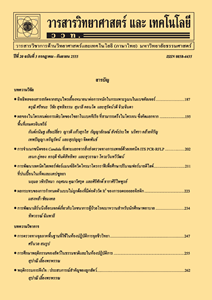การพัฒนาผลิตภัณฑ์เส้นบะหมี่จากวัตถุดิบเนื้อสัตว์
Main Article Content
Abstract
Abstract
This research studied the production of emulsion meat noodles by varying the types of meat (pork and chicken) and noodles shapes. The physical characteristics and chemical compositions of selected meat noodles were also determined. No significant difference was found in appearance, textural and over all liking scores of pork and chicken noodles (p > 0.05), while preference scores were high in color for pork noodles and flavor for chicken noodles with significantly different (p < 0.05). Chicken noodles was easy to set gel forming and displayed smooth product compared with pork noodles. As a result, chicken noodles were selected and used to study the effect of noodles shapes (circle-line noodles, flat, large-strip and star-line) on selected physical properties and sensory acceptance. The result revealed that noodles shapes did not affect color preference (p > 0.05). However, flat noodles had higher appearance and over all liking scores than other shapes (p < 0.05). The lightness, greenness and yellowness of flat noodles were 84.4, 4.6 and 19.6, respectively. Moreover, the tensile force and cooking loss of respective noodles were 22.04 g and 6.5 %, respectively. Flat chicken noodles had moisture content, protein, lipid and ash of 74.5, 14.4, 8.8 and 0.14 %, respectively.
Keywords: chicken; meat; pork; noodle; emulsion
Article Details
References
[2] Brown, A.C., 2011, Understanding Food Principles and Preparation, 4th Ed, Wadsworth Cengage Learning Publisher, Boston, 625 p.
[3] Aberle, E.D., Forrest, J.C., Gerrard, D.E. and Mills, E.W., 2001, Principles of Meat Science, 4th Ed, Kendall/Hunt Publishing Company, Iowa. 354 p.
[4] Paglarini, C.S., Furtado, G.F., Biachi, J.P., Vidal, V.A.S., Martini, S., Forte, M.B.S., Cunha, R.L. and Pollonio, M.A.R., 2018, Functional emulsion gels with potential application in meat products, J. Food Eng. 222: 29-37.
[5] Pretorius, B. and Schonfeldt, H.C., 2018, The contribution of processed pork meat products to total salt intake in the diet, Food Chem. 238: 139-145.
[6] Elsinaite, V., Juraite, D., Schroen, K. and Leskauskaite, D., 2017, Food-grade double emulsions as effective fat replacers in meat systems, J. Food Eng. 213: 54-59.
[7] Choi, Y.S., Sung, J.M., Jeong, T.J., Hwang, K.E., Song, D.H., Ham, Y.K., Kim, H.W., Kim, Y.B. and Kim, C.J., 2016, Effect of irradiated pork on physicochemical properties of meat emulsions, Rad. Phys. Chem. 119: 279-281.
[8] Barros, J.C., Munekata, P.E.S., Pires, M.A., Rodrigues, I., Andaloussi, O.S., Rodrigues, C.E.C. and Trindade, M.A., 2018, Omega-3- and fibre-enriched chicken nuggests by replacement of chicken skin with chia (Salvia hispanica L.) flour., LWT. Food Sci. Technol. 2018: 283-289.
[9] Yasin, H., Babji, A.S. and Ismall, H., 2016, Optimization and rheological properties of chicken ball as affected by K-carrageenan, fish gelatin and chicken meat, LWT. Food Sci. Technol. 66: 79-85.
[10] Ritthiruangdej, P., Parnbankled, S., Donchedee, S., Wongsagonsup, R., 2011, Physical, chemical, textural and sensory properties of dried wheat noodles supplemented with unripe banana flour, Kasetsart J. (Nat. Sci.) 45: 500-509.
[11] Lu, Q., Guo, S. and Zhang, S., 2009, Effects of flour free lipids on textural and cooking qualities of Chinese noodles, Food Res. Int. 42: 226-230.
[12] Kim, C.J. and Lee, E.S., 2003, Effects of quality grade on the chemical, physical and sensory characteristics of Hanwoo (Korean native cattle) beef, Meat Sci. 63: 397-405.
[13] AOAC, 2000, Official Methods of Analysis of AOAC International, 17th Ed., Maryland.
[14] Suman, S.P., Nair, M.N., Joseph, P. and Hunt, M.C., 2016, Factors influencing internal color of cooked meats, Meat Sci. 120: 133-144.
[15] Aaslyng, M.D. and Meinert, L., 2017, Meat flavor in pork and beef- From animal to meal, Meat Sci. 132: 112-117.
[16] Melton, S., 1999, Current Status of Meat Flavor, pp. 115-133, In Xiong, Y.L., Ho, C.T. and Shahidi, F. (Eds.), Quality Attributes of Muscle Foods, Kluwer Academic/Plenum Publishers, New York.
[17] Aaslying, M.D. and Meinert, L., 2017, Meat flavor in pork and beef - From animal to meal, Meat Sci. 132: 112-117.
[18] Ross, A.S., 2006, Instrumental measure ment of physical properties of cooked Asian wheat flour noodles, Cereal Chem. 83: 42-51.
[19] Mudgil, D., Barak, S. and Khatkar, B.S., 2016, Optimization of textural properties of noodles with soluble fiber, dough mixing time and different water levels, J. Cereal Sci. 69: 104-110.


